“The art world is the biggest joke,” he said. “It’s a rest home for the over privileged, the pretentious, and the weak.”
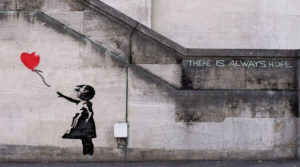
Image source: https://search.creativecommons.org/photos/51d93232-0121-4c78-94c5-b2e55b304a10 by – Dom –
Banksy is a British street artist and activist who, despite his international fame, has maintained an anonymous identity. His satirical street art and subversive epigrams combine dark humour with graffiti executed in a distinctive stenciling technique. His works of political and social commentary have been featured on streets, walls, and bridges of cities throughout the world. Banksy’s work grew out of the Bristol underground scene, which involved collaborations between artists and musicians.
Although he was increasingly famous, Banksy remained anonymous; his rare interviews were conducted via e-mail or with responses delivered by an altered voice on tape. Banksy’s name and identity remain unknown, it has been stated that the reason for this secrecy is that graffiti is a crime.
As of 2014, Banksy was regarded as a British cultural icon, with young adults from abroad naming the artist among a group of people that they most associated with UK culture, which included William Shakespeare, Queen Elizabeth II, David Beckham, The Beatles, Charlie Chaplin, J. K. Rowling, Elton John and Adele.
Info source: https://en.wikipedia.org/wiki/Banksy
Info source: http://www.artnet.com/artists/banksy/
Early Career
Banksy began his graffiti art lifestyle by admiring the works of Blek Le Rat and often recycling his old ideas. He has been very active in the graffiti scene since the early 1990s. Initially, he hung around a graffiti crew in Bristol by the name of DryBreadZ crew or DBZ. Soon after, he began to partner with Inkie, another notable graffiti street artist.
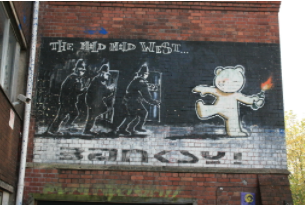
Image source: https://search.creativecommons.org/photos/a220dfd1-d351-43d9-999d-a711423c532e by KylaBorg
The most common form of street art Banksy uses is stencil art. These are often in the form of multi-layered stencils and/or combined with other media sources, such as spray-paint. He also includes anything found in the streets like street signs and other objects to convey his message by crafting beautiful street art installations. His artwork is often satirical and combines dark humor with graffiti and also spreads messages across art, philosophy, and politics.
Info source: http://www.streetartbio.com/banksy
Major Works
He developed a distinctive iconography of highly recognizable images, such as rats and policemen, that communicated his antiauthoritarian message. With wry wit and stealth, Banksy merged graffiti art with installation and performance. In the 2003 exhibition “Turf War,” he painted on the bodies of live pigs. At his “Crude Oils” exhibition in London in 2005, which featured altered replicas of the works of Claude Monet, Vincent van Gogh, and Edward Hopper, he released 200 live rats in the gallery. In 2005 Banksy, fully disguised, installed his own works on the walls of major museums in New York City and London, including the Metropolitan Museum of Art and Tate Britain.
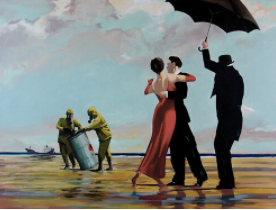
Image source: https://search.creativecommons.org/photos/98d10f51-55f3-4868-a6ca-0097a26676ec by Shht!
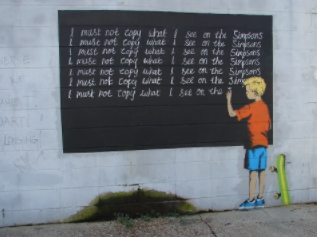
Image source: https://search.creativecommons.org/photos/dff35607-a213-4da2-a84c-8de18f146258 by Mark Gstohl
In 2005 he decided to travel to Palestine and the West Bank, where he stenciled nine images on the Bethlehem Wall.; on the viewer’s side, children play on a forelorn patch of earth, while through an apparent hole in the wall there is a scene of a perfect tropical beach. Banksy described himself as a “quality vandal”, challenging the authority of political and art institutions on both the right and the left. In September 2006 his one-weekend Los Angeles warehouse installation “Barely Legal” for which he decorated a live elephant, attracted large crowds despite a lack of publicity. In Bristol, England, in 2006 he depicted a naked man clinging to a windowsill on the side of a public family-planning clinic; local residents voted to keep the mural.
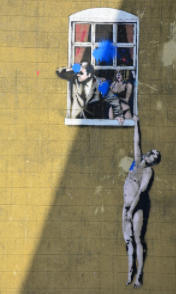
Image source: https://search.creativecommons.org/photos/10f30b6b-3163-416b-9563-5244ba7459df by Ben Sutherland
Info source: https://www.britannica.com/biography/Banksy
The Bansky Effect
“There are crimes that become innocent and even glorious through their splendour, number and excess.”
In December of 2006, journalist Max Foster coined the phrase, “the Banksy effect,” to illustrate how interest in other street artists was growing on the back of Banksy’s success. Because of Banksy’s ubiquity, anonymity and creativity, he has gained recognition and validation from the general public as well as cultural and governmental institutions. Further, Banksy blurs the line between graffiti and art. What to some is vandalism is gallery worthy to others, and Banksy in particular has had many works sold in auctions for hundreds of thousands of dollars. This monetization of street art becomes particularly important for street artists, the art world and even Bristol, England, where Banksy’s graffiti has become a huge cultural and economic benefit to the city.
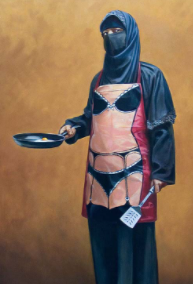
Image source: http://www.banksy.co.uk/img/indoorimg/009_hdylye.jpg Image source: http://www.banksy.co.uk/in.html
Overall, Banksy has been provoking debate about social and political issues, art, authorship, ownership and value – as well as the encouragement of what some say is graffiti.
Info source: https://rebeccakao.wordpress.com/2016/04/06/the-banksy-effect/
Books, Movies and More…
Banksy’s books, which include Banging Your Head Against a Brick Wall (2001), Existencilism (2002), and Wall and Piece (2005)—document his projects; iconic examples of his work, including a life-size image of two policemen kissing, were featured in the bleak futuristic film Children of Men (2006).
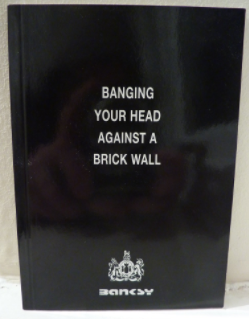
Image source: https://search.creativecommons.org/photos/a4c86a12-6a94-46fa-8a83-14cea13e9ad0 by erokism
Banksy directed the 2010 film Exit Through the Gift Shop, a documentary that ostensibly profiled the lives and work of the world’s most talented graffiti artists. In January 2011, he was nominated for the Academy Award for Best Documentary for the film.
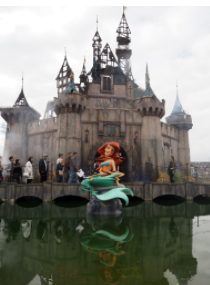
Image source: https://search.creativecommons.org/photos/5b553677-42cf-41c2-835c-ee866511e762 by Ungry Young Man
In September 2015 Banksy debuted Dismaland, his most-elaborate project to date, in Weston-super-Mare, England. The temporary amusement park and conceptual art show, which included work from other artists, was described by Banksy as “a family attraction that acknowledges inequality and impending catastrophe.” Among the sites and features was a fake security checkpoint created by Bill Barminski where visitors’ belongings were examined in a cardboard X-ray machine, and disgruntled greeters circulated through the park wearing shirts that read “Dismal.” The park also hosted late-night parties and concerts by various bands. Dismaland closed in September 2015.

Image source: https://search.creativecommons.org/photos/d8407c1e-0447-42ac-b469-a3bf1edc1f75 by Ungry Young Man
Info source: https://www.britannica.com/biography/Banksy
Political and Social Themes
Banksy once characterised graffiti as a form of underclass “revenge”, or guerilla warfare that allows an individual to snatch away power, territory and glory from a bigger and better equipped enemy. Banksy sees a social class component to this struggle, remarking “If you don’t own a train company then you go and paint on one instead.” Banksy’s work has also shown a desire to mock centralised power, hoping that their work will show the public that although power does exist and works against you, that power is not terribly efficient and it can and should be deceived.
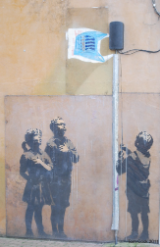
Image source: https://search.creativecommons.org/photos/5214289a-b695-42d9-bc72-d99e317989c5 by tommmmmmmmm
Banksy’s works have dealt with various political and social themes, including anti-war, anti-consumerism, anti-fascism, anti-imperialism, anti-authoritarianism, anarchism, nihilism, and existentialism. Additionally, the components of the human condition that his works commonly critique are greed, poverty, hypocrisy, boredom, despair, absurdity, and alienation.
Info source: https://en.wikipedia.org/wiki/Banksy
